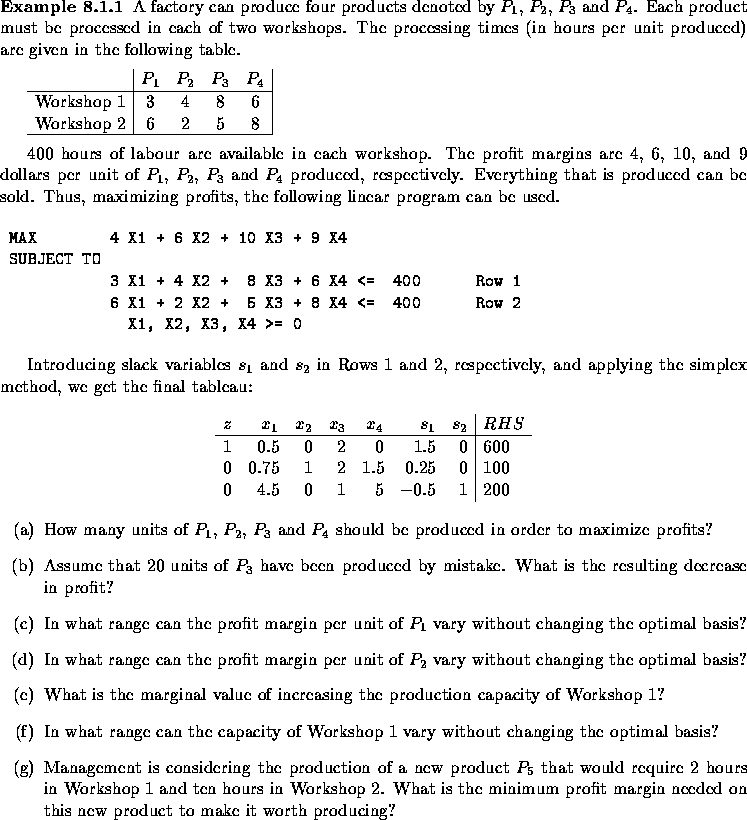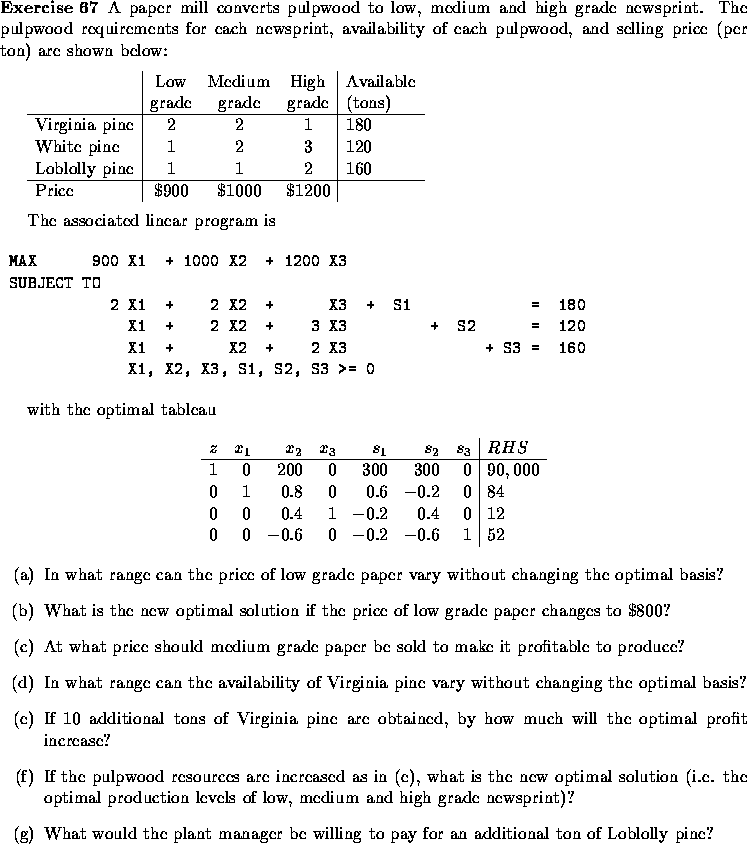The shadow prices can be used to determine the effect of a new variable (like a new product in a production linear program). Suppose that, in formulation (8.1), a new variable w has coefficient 4 in the first constraint and 3 in the second. What objective coefficient must it have to be considered for adding to the basis?
If
we look at making w positive, then this is equivalent to
decreasing the right hand side of the first constraint by 4w
and the right hand side of the second constraint by
3w in the original formulation. We obtain the same effect
by making ![]() and
and ![]() .
The overall effect of this is to decrease the objective by
.
The overall effect of this is to decrease the objective by
![]() .
The objective value must be
sufficient to offset this, so the objective coefficient must be more than
10 (exactly 10 would lead to an alternative optimal solution with no
change in objective).
.
The objective value must be
sufficient to offset this, so the objective coefficient must be more than
10 (exactly 10 would lead to an alternative optimal solution with no
change in objective).

Answers:
(a) From the final tableau, we read that ![]() is basic and
is basic and
![]() are nonbasic. So 100 units of
are nonbasic. So 100 units of ![]() should be produced
and none of
should be produced
and none of ![]() ,
, ![]() and
and ![]() . The resuting profit is $ 600
and that is the maximum possible, given the constraints.
. The resuting profit is $ 600
and that is the maximum possible, given the constraints.
(b) The reduced cost for ![]() is 2 (found in Row 0 of the final
tableau). Thus, the effect on profit of producing
is 2 (found in Row 0 of the final
tableau). Thus, the effect on profit of producing ![]() units of
units of
![]() is
is ![]() . If 20 units of
. If 20 units of ![]() have been produced by mistake, then
the profit will be
have been produced by mistake, then
the profit will be ![]() lower than the maximum
stated in (a).
lower than the maximum
stated in (a).
(c) Let ![]() be the profit margin on
be the profit margin on ![]() . The reduced
cost remains nonnegative in the final tableau if
. The reduced
cost remains nonnegative in the final tableau if ![]() .
That is
.
That is ![]() . Therefore, as long as the profit margin
on
. Therefore, as long as the profit margin
on ![]() is less than 4.5, the optimal basis remains unchanged.
is less than 4.5, the optimal basis remains unchanged.
(d) Let ![]() be the profit margin on
be the profit margin on ![]() . Since
. Since ![]() is
basic, we need to restore a correct basis. This is done by adding
is
basic, we need to restore a correct basis. This is done by adding
![]() times Row 1 to Row 0. This effects the reduced costs of
the nonbasic variables, namely
times Row 1 to Row 0. This effects the reduced costs of
the nonbasic variables, namely ![]() ,
, ![]() ,
, ![]() and
and ![]() .
All these reduced costs must be nonnegative. This implies:
.
All these reduced costs must be nonnegative. This implies:
![]()
![]()
![]()
![]() .
.
Combining all these inequalities, we get ![]() . So,
as long as the profit margin on
. So,
as long as the profit margin on ![]() is 6 or greater, the optimal
basis remains unchanged.
is 6 or greater, the optimal
basis remains unchanged.
(e) The marginal value of increasing capacity in Workshop 1 is
![]() .
.
(f) Let ![]() be the capacity of Workshop 1. The resulting RHS
in the final tableau will be:
be the capacity of Workshop 1. The resulting RHS
in the final tableau will be:
![]() in Row 1, and
in Row 1, and
![]() in Row 2.
in Row 2.
The optimal basis remains unchanged as long as these two quantities
are nonnegative. Namely, ![]() . So, the optimal
basis remains unchanged as long as the capacity of Workshop 1 is in
the range 0 to 800.
. So, the optimal
basis remains unchanged as long as the capacity of Workshop 1 is in
the range 0 to 800.
(g) The effect on the optimum profit of producing ![]() units
of
units
of ![]() would be
would be ![]() . If the profit margin on
. If the profit margin on ![]() is sufficient to offset this,
then
is sufficient to offset this,
then ![]() should be produced. That is, we should produce
should be produced. That is, we should produce ![]() if
its profit margin is at least 3.
if
its profit margin is at least 3.

